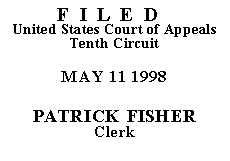

| R. LEON SMITH and S. DIANE SMITH, |
No. 97-2057 (D.C. No. CIV-96-878-LH) |
Leon and Diane Smith farmed land in Curry County, New Mexico, which was sold in a foreclosure action. During the proceeding, the Smiths, appearing pro se, filed a counterclaim against FmHA which they ultimately agreed to dismiss with a stipulation that the claims made by the Smiths "remain viable for independent adjudication."
Relying upon Bivens v. Six Unknown Named Agents, 403 U.S. 388 (1971), the Smiths filed this action in June 1996 alleging Frank Glover, Thomas Hunton, and Winfred Riley, FmHA officials, committed violations of plaintiffs' rights to due process and equal protection under the Fifth Amendment as well as various violations of FmHA rules and procedures. The Smiths sought injunctive relief "to insure that they can obtain FmHA loans and loan servicing in the future" and unspecified damages. Defendants moved to dismiss on grounds of failure to state a constitutional claim, statute of limitations, and qualified immunity.
The district court granted the motion primarily upon statute of limitations grounds.(1) First, it found the actions complained of in this action initially arose in March 1991 and reoccurred in March 1993. The court then concluded the nature of those allegations triggered a three-year statute of limitations, making the present action filed in June 1996 untimely. The court next found the reservation of claims in the foreclosure action did not toll the statute of limitations because the Smiths' claims were asserted against the FmHA and not the individual defendants in this case.
On appeal, the Smiths raise three issues, none of which has merit. What the Smiths ignore is they have chosen to bring a new action against three individuals who were not parties to the prior suit instituted by the FmHA. Moreover, the counterclaims they asserted in that prior action were made against the agency, and not the individuals. Independently, these factors are sufficient to bar their claims here regardless of their arguments to the contrary.
Bivens, the jurisdictional basis for the present action, is a judicially created remedy having no inherent limitation of action; consequently, it borrows from any closely analogous state statute of limitations. Industrial Constructors Corp. v. United States Bureau of Reclamation, 15 F.3d 963, 968 (10th Cir. 1994). In this case, New Mexico's three-year limitary period for personal injury applies. Id. However, we look to federal law to determine when a cause of action accrues. "The statute of limitations begins to run when the plaintiff knows or has reason to know of the existence and cause of the injury which is the basis of his action." Id. at 969.
Plaintiffs alleged they were injured by a March 1991 denial of loan restructuring or lease/buy back; a January 1992 objection to their failed bankruptcy Chapter 12 plan; and a March 1993 rejection of loan restructuring. Thus, it is indisputable that in March 1993, the Smiths knew their efforts to obtain any FmHA relief were stillborn. Accordingly, the Smiths had until March 1996 to file their Bivens action.
Their resort to the New Mexico tolling statute must fail because different parties are involved and the actions are totally dissimilar. Rito Cebolla Investments, Ltd. v. Golden West Land Corp., 607 P.2d 659, 666 (N.M. Ct. App. 1980) (The tolling statute requires both actions involve the same parties, the same cause of action, and the same right appearing from the record.). Even if the foreclosure counterclaim included similar allegations, it was a different cause of action against different parties.
Although the Smiths characterize the language in the stipulation to dismiss the foreclosure action as deceptive, any plain reading produces the conclusion the parties wanted to be clear the foreclosure was dismissed with prejudice leaving the counterclaim viable for the Smiths to pursue. Under any scenario, it is impossible to reshape that possibility into the basis for equitable tolling.
Having reached this point, we do not need to consider the Smiths' argument regarding qualified immunity. The lack of timeliness of this action is adequate grounds for its dismissal.
The motion to supplement the record is GRANTED, and the judgment of the district court is AFFIRMED.
ENTERED FOR THE COURT
John C. Porfilio
Circuit Judge
*. This order and judgment is not binding precedent, except under the doctrines of law of the case, res judicata, and collateral estoppel. This court generally disfavors the citation of orders and judgments; nevertheless, an order and judgment may be cited under the terms and conditions of 10th Cir. R. 36.3.
1. The court also noted in passing the defendants were entitled to qualified immunity.